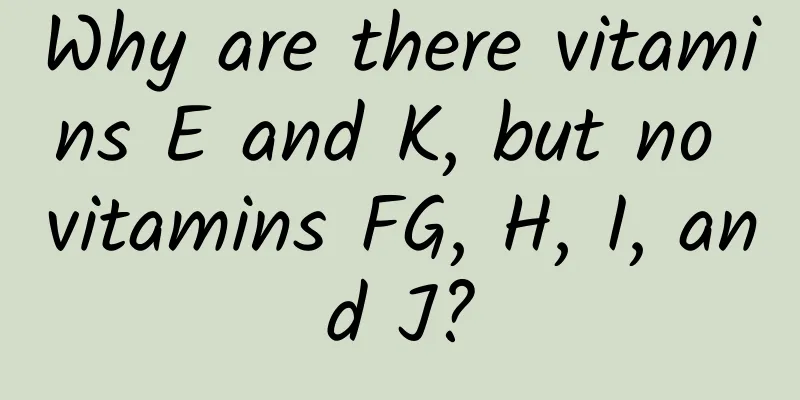Why are there vitamins E and K, but no vitamins FG, H, I, and J?

|
We are all familiar with vitamins ABCDE, but if we go further down, the next member of the vitamin family is directly vitamin K. Where did the vitamins FGHIJ in the middle go? Let’s start with the name “vitamin”. Vitamins found in chickens In 1886, beriberi (not foot odor) was rampant among Dutch soldiers and sailors, so scientist Christiaan Eijkman chose to experiment with chickens to search for possible pathogens. What followed was a famous incident in the history of science. Ekman discovered that the chicken feed was changed from brown rice to polished rice, and the symptoms of beriberi in the chicks appeared when they ate polished rice and disappeared when they were fed brown rice. Eventually, Ekman determined that there was a substance in brown rice that could treat beriberi. In 1912, Casimir Funk successfully isolated this substance and named it "vitamin." The word "vitamin" was originally written as "Vitamine", which is the Latin word for life "vita" + "amine", which roughly means amines needed for life (but later it was discovered that vitamins contain more than just amines, so the "e" was removed and the name was changed to Vitamin). You see, when the concept of "vitamin" first appeared, its definition was very broad: amines required for life, so how many substances would meet the requirements? Vitamin A~Z once planned In the decades that followed, many people claimed to have discovered new vitamins. Many of them were the same substances discovered independently by different teams, or were actually mixtures, but they were all given the fashionable name of "vitamin". You can't blame them for this. Originally, vitamins referred to amines required for life; now, we think that vitamins refer to substances that are trace amounts in the body but are very important for normal physiological functions, in addition to the three major nutrients (fats, proteins, and carbohydrates). The amount synthesized by the human body itself often cannot meet the needs, but once it is deficient, it will cause specific diseases. Vitamins have never been a rigorous chemical name like "ethanol" or "2-methyl-1,4-naphthoquinone", but a broad nutritional concept, with no similarities in chemical structure and physical and chemical properties. Therefore, there have been many things called "Vitamin xx", just as you and I were once called "Zang Ai xx" and later changed to other decent online names. However, in the process of discovering vitamins, people also had a naming plan. In 1915, people discovered that the "vitamins" named by Funk actually contained two substances, fat-soluble and water-soluble. These two substances were named vitamin A and vitamin B respectively. At that time, people decided that if new vitamins were discovered in the future, they would be listed in the alphabet from A to Z. The chaos started with vitamin F Vitamin C, vitamin D, and vitamin E all appeared according to this rule, but something went wrong with vitamin F. In the 1920s, people discovered that vitamin B was not a single substance, but a group of substances. Scientists quickly found two of them and called them "vitamin F" and "vitamin G." However, since these two substances were separated from vitamin B, many people also call them "vitamin B1" and "vitamin B2." In 1927, the Food Added Factors Committee under the British Medical Research Council directly approved the names of "Vitamin B1" and "Vitamin B2", while the names of "Vitamin F" and "Vitamin G" were no longer used. Soon after, "Vitamin F" was picked up again as the name of essential fatty acids for the human body. As research expanded and deepened, people realized that essential fatty acids are actually components of fat, and fat is not a vitamin. Therefore, essential fatty acids were removed from the list of vitamins, and the name "Vitamin F" was abandoned again and has not been used in any official occasions until now. The most confusing thing is the vitamin B family If vitamin F was abandoned after being used, then the vitamin B family that still exists today is the AKB48 of the vitamin world, with members coming and going like flowing water. After the discovery of vitamin B1 and vitamin B2, the vitamin B family continued to grow. B3, B4, B5, B6... B17 came out one after another, among which B12 also had three younger brothers: B12a, B12b, and B12c; someone also found that one of the factors was needed by chickens, so it was named vitamin Bc ("c" is the first letter of the English word "chicken"). However, the vitamins you know now are probably only B2, B6 and B12, and the rest of the B vitamins that have sprung up have disappeared one after another. The reason for this is largely because they are actually mixtures of other vitamins, and there is also the problem of repeated naming by different researchers. Vitamin B10 and B11 may be a mixture of the same type consisting of folic acid and B12; Vitamin B7 and vitamin I also point to the same mixture; Vitamin Bc was discovered and vitamin M was actually folic acid, so both names were later abandoned; In addition, some vitamins have followed the trend and have been named with names that people are more familiar with, such as "pantothenic acid" is actually vitamin B5, and "folic acid" is actually vitamin B9; Some vitamins are related to business. For example, "Vitamin U" is a substance that may have anti-ulcer effects. "U" comes from the first letter of the English word "ulcer". But there is no evidence that it is essential to the human body, so it is not a serious vitamin. At present, some drugs containing this substance are still using names such as "Vitamin U" and "Vitamin U", probably because the three words "vitamin" sound sunny and friendly - a guess, not necessarily correct. Okay, to sum up: vitamins FGHIJ and most of the following vitamins have been expelled from the "vitamin category" because they have the same name, are essentially mixtures, and do not meet the definition of vitamins; a few have more trendy names, such as pantothenic acid, folic acid, and biotin. Rectify vitamins Because the naming history of vitamins was so confusing, the International Union of Nutritional Sciences (IUNS) finally took over the matter and established the current vitamin naming principles in 1978. The principles are too long, for example, it stipulates that "niacin" is the general name for pyridine-3-carboxylic acid compounds and their derivatives with nicotinamide-like biological activity... In short, the chaos in the vitamin family finally came to an end. References [1]Capenter, KJ (2000). Beriberi, White Rice andVitamin B: A Disease, a Cause, and a Cure. University of California Press, Los Angeles, 282 pp. International Union of Nutritional Sciences (1976). [2]Generic descriptors and trivial names for vitamins and related compounds: recommendations. In Nutrition Abstracts and Reviews (1978), 48A, 831–835. [3]Spector, AA, & Kim, HY (2015). Discovery of essential fatty acids. Journal of lipid research, 56(1), 11–21. [4]Wald, G. (1933). Vitamin A in the retina Nature(London) 132, 316. [5] Gerald F. Coombs, Jr., translated by Zhang Danshen, & Du Guanhua. (2009). Vitamins: Nutrition and the Basis of Health. Science Press. Author: Huang Hui Editor: Li Xiaokui |
<<: Kidney disease can not eat soy products? It's all a misunderstanding
>>: You can’t just choose a wheelchair randomly. Have you ever heard of wheelchair prescription?
Recommend
Knowledge on prevention of infectious diseases in spring
PART TWO A guide to common infectious diseases pr...
Is it normal to have tummy pain due to fetal movement?
When the baby is about to be born, there will be ...
Four and a half months pregnant leucorrhea yellow
For many women, leucorrhea is a normal secretion ...
A kissing method for women can help prolong life
Kissing is not only an important symbol of love b...
The difference between miscarriage bleeding and menstruation
When miscarriage occurs, there will be bleeding, ...
What causes dizziness when standing up? Or these factors are to blame
Many women often experience this symptom, that is...
Can pregnancy be detected after one day of menstruation?
Can pregnancy be detected after one day of menstr...
Signs of caesarean section fat liquefaction
Generally, the stitches on the wound from a cesar...
What to do if your uterus is enlarged due to adenomyosis
In recent years, more female friends have develop...
Can I eat black fish during confinement?
Confinement means that a pregnant woman takes one...
When high blood pressure meets a cold and fever, how should you choose the antipyretic medicine?
Spring is approaching, and the temperature differ...
Know more about medicine | Why should patients with cardiovascular disease use celecoxib with caution?
During his ward rounds, Dr. Jiang from the Depart...
What is the way to make your private parts pink?
In fact, normal sexual life will not cause the pr...
What to do about test anxiety?
This is the 4959th article of Da Yi Xiao Hu One d...
The harm of two consecutive months of abortion
Nowadays, advertisements about abortion are every...









